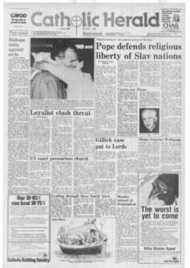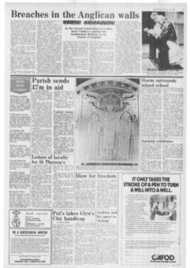Page 5, 5th July 1985
Page 5

Report an error
Noticed an error on this page?If you've noticed an error in this article please click here to report it.
Tags
Share
Related articles
Visit To Martyr's Cell
Kent Celebrations
St. John Fisher: The Real Man
A Martyr In The Toolshed
A Coach Drove Back To Old England
The path to Tower Hill
With fellow pilgrims Terence Sheehy recently followed St John Fisher's journey from Rochester to the scaffold
TO MARK the 450th anniversary, to the day, of the martyrdom of St John Fisher, we had the privilege of joining Mgr Anthony Stark, Master of the Guild. of Our Lady of Ransom, and members of the Guild, on their pilgrimage to Rochester.
Thence we proceeded to the Tower of London, to visit the martyr's prison cell, his place of execution on Tower Hill, and his burial place in the church of St Peter ad Vincula in the Tower of London.
It was a moving and memorable day. On the journey down to Rochester, to the Cathedral of which St John Fisher was bishop, Mgr Stark gave a lucid picture of the most learned theologian who was appointed to the smallest diocese in England, in 1504, with revenues worth only £300 a year.
This bishop of Rochester was a man of extraordinary piety, a pastoral bishop, who wore a hair shirt, prayed constantly, slept for only four hours a night on a bare board, ate sparingly, and gave all his money and possessions to the poor of his diocese.
His "Palace" at Rochester, adjacent to the Cathedral, was cold and draughty and the fare frugal, as visitors such as Erasmus and Wolsey observed. This pastoral bishop spoke of the need for "golden priests" rather than "golden churches" in a world of an opulent hierarchy and an outrageously lax and worldly clergy.
Our Anglican brothers and sisters in Rochester showed early signs of ecumenism when in 1935 they erected a plaque on the wall of his palace which refers to him generously as he "who laid down his life for his faith on Tower 11111". In a similar gesture his coat of arms as Bishop of Rochester is high up upon the wall of the Norman nave, next to that of the Protestant martyr, Nicholas Ridley, who was burnt at Oxford in 1555.
On the south side of the choir screen across the Cathedral nave, erected in 1888, the honours are given to four figures carved in stone, from left to right: Bishop Ciundulph, the Norman builder 1077 to 1107; William Hoo, builder of the choir, 1227; Bishop Walter of Merton, founder of Merton College, Oxford, 1274, and Cardinal Fisher, beheaded on 'Tower Hill, 1535.
As we stood outside the wall of Fisher's Palace in Rochester we recalled that he was the outstanding theologian of his time, able to take on Luther, and to talk on equal terms with Erasmus, following his years at Cambridge, where he had been Chancellor of his university. He lived in the frightening times of the Tudor terror of an upstart King.
Even the Archbishop of Canterbury of the time lied to Henry VIII by alleging Fisher's support, along with that of the entire hierarchy, refusing to allow Queen Catherine of ,Aragon's appeal against the competence, the constitution and the impartiality of the legatine court meeting at Blackfriars.
Fisher saw clearly through the Tudor despot's lust for Anne Boleyn, while the Medici Pope in Rome prevarciated, and the English Hierarchy submitted totally to the will of Henry VIII.
While meditating on this we were much moved to behold the Franciscan Bishop, Agnellus Andrew, celebrating the first Mass in Rochester Cathedral since the Reformation, on the very spot where Fisher had celebrated in his day. But, to return to Tudor times, hell bath no fury . . . and not surprisingly the Boleyn family made a number of attempts on the life of Fisher, the first by bribing his cook to poison him. He survived, but two of his household died. Then there were gunshots, piercing the house close to where he was accustomed to sit.
We returned from Rochester by the same mute as that taken by the sick and aged Fisher, when he was summoned by the commissioners to appear at Lambeth Palace for refusing to swear the oath to the 1534 Act of Succession. 11v this Act Catherine's marriage was declared
RECENTLY COMPLETED for St John Fisher Church, Cannon Hill Lane, London by sculptor John Quail, this 4.ft 6 inch, high statue of the martyred saint shows him holding the book he wrote in his cell for his Dominican sister and the Gospel, slightly open at John 17.3, the passage he read before going to the scaffold. The iroko wood for the figure was obtained from Chatham Dockyard, which must have been in Fisher's diocese when he was Bishop of Rochester.
invalid, and the secret marriage of the King to the pregnant Anne Boleyn, of January 1533, was declared valid.
Fisher rode out bare headed from his palace, and bade farewell to a weeping crowd. He was sick and frail, and his captors feared that he was about to die as he struggled to ride up Shooters Hill, and then made the descent into London, to be committed to Lambeth Palace.
By horse, and then by barge on the river, he was taken to the Tower of London on April 17, 1534. (St Thomas More was a few yards away from him, in prison for the same reason). Fisher had given away practically all his money and few possessions, and now found he was required to pay £1 per week for his keep, about £350 a week in our money today.
The Bell Tower, in which he was imprisoned for 14 months, is on the south west corner of the Tower of London, a circular prison partly facing the cold waters of the river Thames, just west of Traitor's Gate. His was a first floor cell, 18 feet in diameter, with a wide fireplace, and four or five pointed gothic arches rising to a vaulted ceiling, and with one small arched window.
The walls are of rough masonry, white washed, and the cell today is probably more spacious than in his time. It can be reached by walking along the narrow rampart of the inner curtain from the Beauchamp Tower.
The frail, sick and tired old man'of nearly 70 years, starved and frozen, with inadequate clothing, looking more like a corpse than a living being, was treated with utter contempt by his jailers and by the members of the council.
On the morning of his execution he was awakened by his jailer at 5am, and told that he was to die at 10am. He calmly returned to sleep for a couple of hours as, because of "my great sickness and weakness" he had not slept well that night. He was so weak that he had to be carried in a chair to Tower Hill, the place of his execution.
At the point outside the Tower where the Sheriffs of London took over they arrived an hour late. So he leaned against the wall and meditated, and opened his Bible at random, and read: "Now this is eternal life: That they may know thee, the only true God, and Jesus Christ, who thou has sent. 1 have glorified thee on earth: 1 have finished the work which thou gayest me to do. And now, glorify thou me, 0 Father, with thyself".
Despite his feebleness he climbed the steep ladder, unassisted, to the execution block. When his garments were removed, a great groan went up from the assembled crowds when they saw his emaciated body. Fisher said the "Te Deum, and then the Psalm, "In Te Domine speravi, non confundar in aeternum".
The axe fell at 10 o'clock on the morning of 22 June 1535. His headless body was left on the scaffold, half naked for some hours. The Tudor monarch had decreed that his body was to be denied a Christian burial, so the soldiers spiked his corpse on their halberds and tossed it on a refuse heap near All Hallows Churchyard.
His head was part boiled and exposed on a pike on London Bridge. As it became "fresher and more comely day by day", and as it appeared to smile on the dense crowds below, his head was thrown into the river Thames by the alarmed authorities.
His body now lies, with that of Thomas More and others, in the crypt of the Tower Chapel of St Peter's ad Vincula, a stone's throw away from the Bell Tower.
Today, but for the interest of such august bodies as that of the Guild of Our Lady of Ransom, the Tower is a tourist trap to which noisy crowds of Japanese, American, French and other nationalities flock to see the Crown Jewels the Beefeaters, the Ravens, and the stamping guards, and the NCOs screaming at the crowds, "Make way for the Queen's Guard!"
blog comments powered by Disqus











